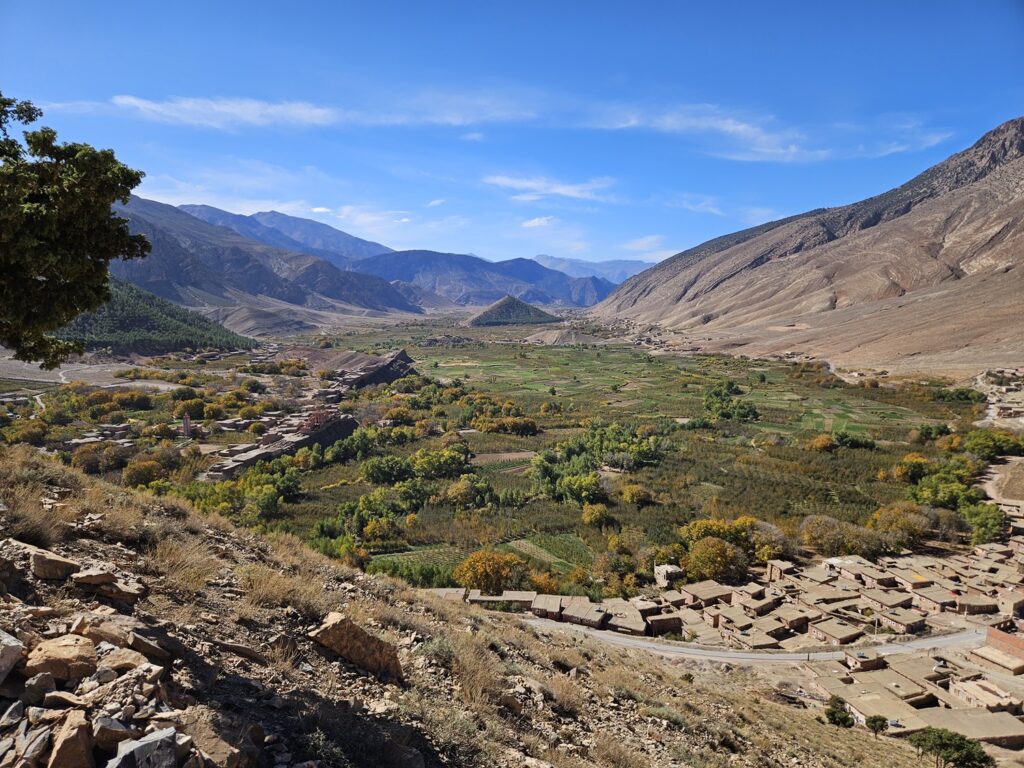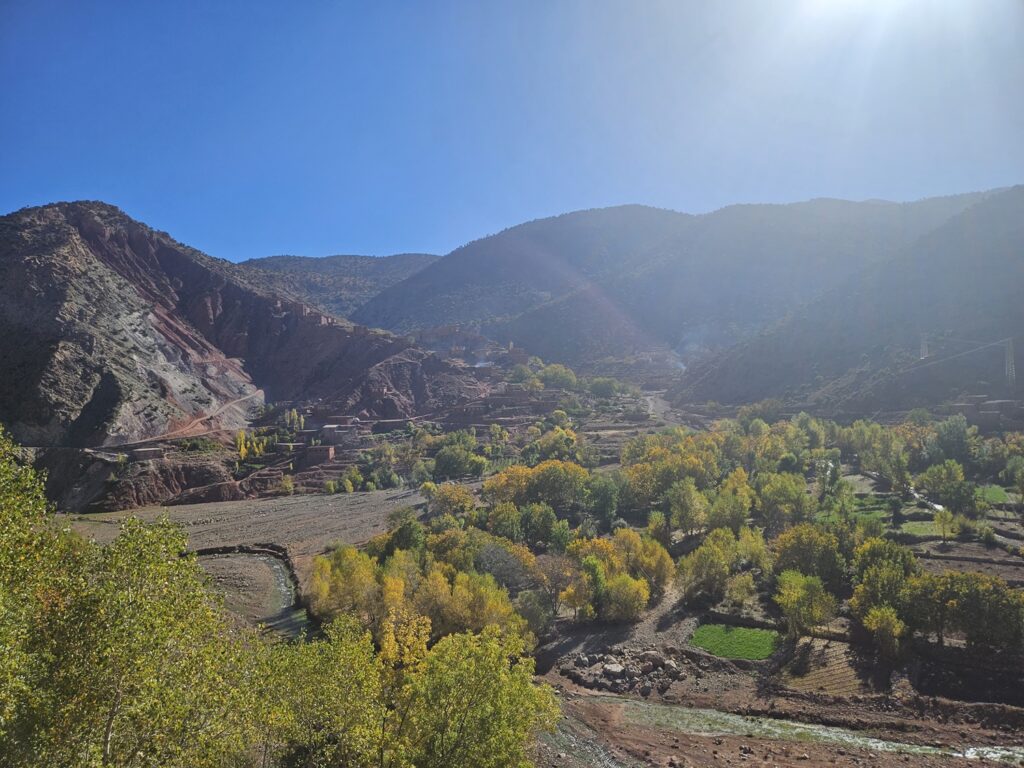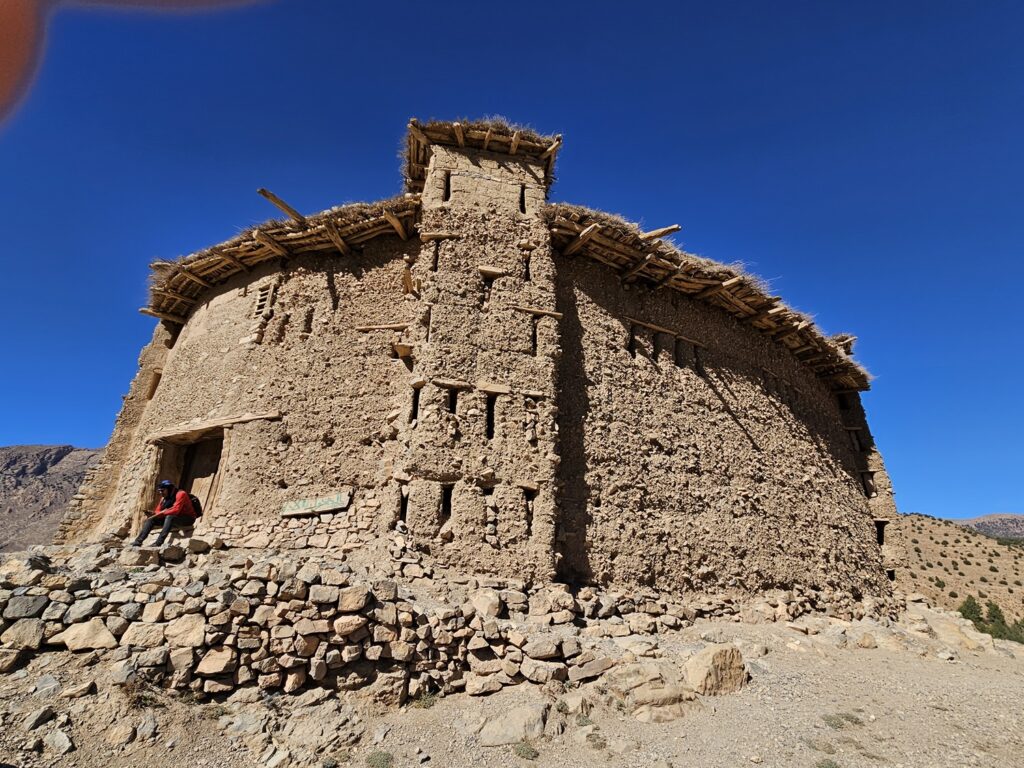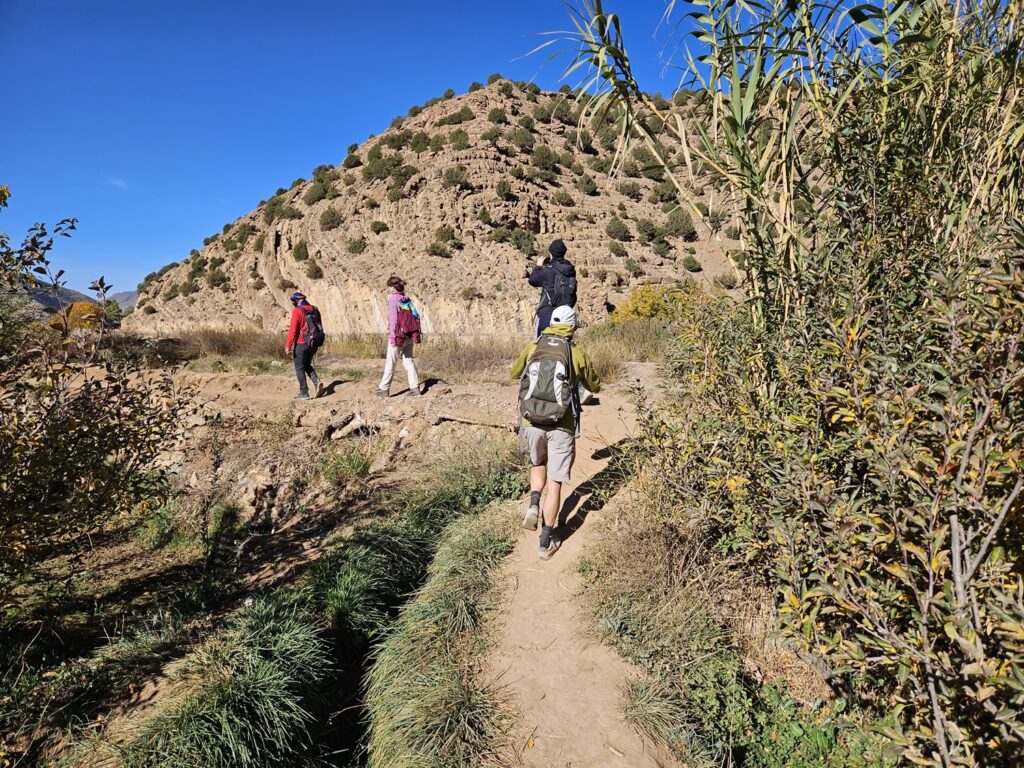
Nestled in the heart of the central High Atlas in Morocco, the Ait Bouguemez Valley, nicknamed the “Little Moroccan Tibet,” is a region that captivates with its striking natural beauty and authentic Berber culture. This verdant valley, stretching for about 30 kilometers, offers a varied landscape of fertile fields, majestic mountains, and traditional villages.

Geography and Climate
The valley is characterized by its unique topography, bordered by high mountains including the famous M’Goun. The climate varies considerably with the seasons, offering pleasantly warm summers and cold, often snowy winters, making it an ideal place for hiking and exploration throughout the year.
Geography
The Ait Bouguemez Valley, a hidden gem in the central High Atlas of Morocco, is a remarkable demonstration of geographical diversity. Extending over approximately 30 kilometers, this fertile valley is framed by impressive peaks, including M’Goun, which rises to 4,071 meters and is the second highest summit in Morocco. The valley’s terrain is characterized by a mix of rolling plateaus, deep gorges, and steep cliffs, offering a spectacular panorama at every turn.
The rivers that meander through the valley play a crucial role in shaping the landscape. One of the most important is the Oued M’Goun, which irrigates the lands and contributes to the soil’s fertility. Traditional irrigation systems, such as earthen canals, are evidence of the inhabitants’ adaptation to this mountainous terrain and their ingenuity in exploiting water resources for agriculture.
Climate
The climate of the Ait Bouguemez Valley is typical of high mountain regions, with marked variations between the seasons. Summer is generally warm and sunny, offering ideal conditions for hiking and exploration. This season is marked by clear days, allowing for stunning views of the surrounding mountains, and temperatures that can reach 30°C during the day, although nights remain cool.
Winter, on the other hand, transforms the valley into a winter landscape, with temperatures that can drop below zero and frequent snowfalls, especially on the higher peaks. These snowy conditions attract winter sports enthusiasts, although the hiking trails are less accessible.
The interseasons, spring and autumn, are transition periods where the climate is particularly pleasant. Spring sees the melting of the snow and the blooming of wildflowers, turning the valley into a colorful carpet, while autumn offers a display of warm colors with mild temperatures.
The climate of the Ait Bouguemez Valley has a direct impact on the lives of the inhabitants and on tourist activities. Understanding these climatic conditions is essential for planning a visit to this magnificent region of Morocco.
History and Culture
The inhabitants of the valley, the Ait Bouguemez, are Berbers who have preserved a traditional way of life. Their history is rich, marked by ancestral traditions and a preserved cultural heritage. The fortified granaries, or “Ighrems”, testify to their ingenuity and history.
History
The Ait Bouguemez Valley is steeped in a rich history that is reflected in its landscape and traditions. The Berbers, the indigenous people of this region, have inhabited these mountains for millennia. Their presence dates back to antiquity, as evidenced by the numerous archaeological sites and rock carvings scattered throughout the valley, illustrating the long human history of this region.
Over the centuries, the valley has been the scene of various historical events, including invasions and trade exchanges. It served as a refuge for local populations during Arab invasions and played a key role in the Trans-Saharan trade routes. These external influences have enriched Berber culture while preserving its unique character.
Culture
The culture of the Ait Bouguemez is deeply rooted in Berber traditions. The Amazigh language, also known as Berber, is the mother tongue of most inhabitants. This language and its various dialects are a key element of the valley’s cultural identity.
Music and dance play a central role in the social life of the Ait Bouguemez. Festivals and celebrations are often accompanied by traditional Berber music, with instruments like the lute (oud) and drums. The dance, rhythmic and energetic, is an expression of joy and community.
Craftsmanship is another important aspect of local culture. The inhabitants of the valley are skilled in the arts of tapestry, pottery, and basketry. These artisanal objects are not only functional but also represent a cultural heritage, with patterns and techniques passed down from generation to generation.
The culinary traditions of the valley also reflect its cultural heritage. The cuisine is mainly based on local products, with dishes like couscous, tagine, and Berber bread baked in earthen ovens. These meals are often shared during community gatherings, strengthening social bonds and solidarity.
Social structures in the valley are strongly influenced by family and clan systems. Solidarity and mutual aid are core values, as evidenced by communal agricultural practices and water management systems.
In summary, the Ait Bouguemez Valley is a place where history and culture harmoniously intersect. The living Berber traditions in this isolated valley offer a fascinating glimpse into a way of life that has withstood the test of time and the changes of the modern world.
Architecture and Habitat
The villages in the valley, such as Tabant, are characterized by typical earthen houses of Berber architecture. These houses are often surrounded by lush gardens, creating a harmonious landscape that blends into the natural setting.
Traditional Architecture
The Ait Bouguemez Valley, located in the Moroccan High Atlas, is renowned for its traditional architecture, which harmoniously integrates into the surrounding mountainous landscape. The houses, known as “tighremt” in Berber, are primarily built from mudbrick and stone, reflecting an ancestral adaptation to the climatic conditions and locally available materials.
These mudbrick structures, mixed with straw and stones, offer excellent insulation, keeping the interior cool during hot summers and retaining heat during harsh winters. The earthy color of these buildings allows them to blend into the natural landscape, underscoring the deep connection between the inhabitants and their land.
Characteristics of the Houses The Berber houses in the Ait Bouguemez Valley are often characterized by flat roofs and thick walls. The roofs serve various domestic activities, including drying crops. The windows are generally small, minimizing heat loss and offering protection against the elements.
Inside, the houses are designed to meet the needs of family and communal life. Rooms are typically versatile, serving as living rooms, bedrooms, and dining areas. The interior decoration often reflects local craftsmanship, with colorful rugs, woven textiles, and earthenware utensils.
Community Granaries
A distinctive element of the valley’s architecture is the presence of fortified community granaries, known as “Ighrem”. These imposing structures, often built high for defensive purposes, were used to store provisions and valuables. Their robust construction is a testament to the ingenuity of the ancient inhabitants in facing the challenges of their environment.
Adaptation and Modernization
While traditional architecture predominates, the Ait Bouguemez Valley has seen some modernization. New constructions sometimes incorporate modern materials like concrete, while trying to preserve the aesthetics and functionalities of traditional designs. This fusion of old and new reflects the ongoing evolution of culture and habitat in the valley.
Habitat as a Reflection of Culture Architecture and habitat in the Ait Bouguemez Valley are intimately linked to the lifestyle and culture of its inhabitants. The houses are not just living structures; they represent a communal way of life, rooted in traditions and adapted to the environment. Small gardens, domestic animals, and workspaces around the houses testify to the importance of agriculture and self-sufficiency.
Agriculture and Lifestyle
Agriculture is the backbone of the local economy. The inhabitants practice subsistence farming, mainly cultivating cereals and raising livestock. This agricultural lifestyle shapes the landscape of the valley, with terraced fields and complex irrigation systems.
Agriculture:
Pillar of the Local Economy Agriculture in the Ait Bouguemez Valley is more than an economic activity; it is at the heart of the inhabitants’ way of life. Practiced for generations, it is based on traditional methods adapted to the mountainous terrain and the climate of the region. The main crops include cereals like barley and wheat, essential to the local diet. Fruits, including apples, nuts, and apricots, are also cultivated, benefiting from the valley’s moderate climate.
Irrigation systems play a crucial role in the valley’s agriculture. The irrigation canals, known as “seguias”, are carefully maintained and managed communally. This water management reflects the cooperation and social organization of the villages, where each family receives a water allocation according to an established schedule.
Livestock and Biodiversity
Livestock farming is another important component of the agricultural economy. The inhabitants mainly raise sheep, goats, and cattle. Livestock is raised extensively, with animals grazing freely in the mountain pastures. This practice not only contributes to the local economy but also plays a role in preserving the biodiversity and ecosystems of the region.
Lifestyle and Traditions
The lifestyle in the Ait Bouguemez Valley is strongly influenced by agriculture. Daily activities are rhythmed by agricultural seasons, harvests, and livestock rearing. The community is closely knit, with families and neighbors supporting each other in agricultural work and daily activities.
Cultural traditions are also closely linked to agriculture. Festivals and celebrations are often organized around important agricultural events, like the harvest. The local cuisine, rich and varied, reflects the abundance of agricultural products in the valley. Traditional dishes, like couscous and tagine, are prepared with fresh, local ingredients.
Challenges and Future
However, agriculture in the valley faces various challenges, including climatic variations and modernization. Preserving traditional agricultural methods and sustainable management of natural resources are essential for the valley’s future. Efforts are being made to integrate sustainable agricultural practices and to support the local economy while preserving the unique environment and culture of the valley.
Tourism and Challenges
Tourism in the Ait Bouguemez Valley has developed in recent years, attracting hikers and nature enthusiasts. However, this development poses challenges in terms of sustainability and preservation of the local culture. Ecotourism initiatives have been established to ensure a balance between economic development and the protection of the environment and culture.

Tourism Development
The Ait Bouguemez Valley, with its picturesque landscapes and rich Berber culture, has become an increasingly popular destination for tourists. Its appeal lies in its hiking opportunities, unique cultural heritage, and tranquility away from bustling urban centers. Visitors are drawn to the natural beauty of the valley, the trekking possibilities in the High Atlas, and the chance to experience a traditional way of life.
Impact on the Local Community The increase in tourism has had a significant impact on the local community. On one hand, it has created economic opportunities, with the development of accommodation, guide services, and local crafts. This has provided additional income for residents. On the other hand, the influx of visitors poses challenges in terms of preserving culture and the environment. There is a risk that the growth of tourism could alter the traditional way of life and put pressure on natural resources.
Environmental Challenges
Tourism also brings environmental challenges. The increase in visitors can lead to increased pollution, erosion of hiking trails, and pressure on local ecosystems. Managing these impacts is crucial to ensure the sustainability of the valley’s environment.
Sustainable Tourism Initiatives
In response to these challenges, sustainable tourism initiatives are being implemented. These initiatives aim to promote tourism that benefits the local community while minimizing environmental impact. This includes the development of eco-friendly accommodation, raising tourists’ awareness of local culture and the environment, and supporting locally owned tourism businesses.

Promoting Culture and Heritage
A crucial aspect of tourism in the Ait Bouguemez Valley is the promotion and preservation of Berber culture. Tourist activities such as village tours, craft demonstrations, and cultural exchanges are encouraged. These interactions offer visitors a deeper understanding of the local culture and contribute to its preservation.
Towards a Sustainable Future For sustainable tourism development in the Ait Bouguemez Valley, it is essential to find a balance between welcoming tourists and preserving the unique way of life and environment of the valley. This requires collaboration among local communities, government authorities, and tourism organizations. By fostering a respectful and inclusive approach, the valley can continue to be a place where visitors can appreciate its natural beauty and rich culture, while positively contributing to its future.
Tourist Activities Activities for visitors are varied: hiking in the mountains, visiting traditional villages, discovering local cuisine, and participating in cultural festivals. These activities offer visitors an immersive experience in Berber life and culture.
Hiking and Exploration
The Ait Bouguemez Valley is a paradise for hikers, offering a multitude of trails that wind through the mountainous landscape of the High Atlas. Hiking routes vary in difficulty, suitable for both beginners and experienced hikers. Visitors can explore imposing peaks, deep gorges, and verdant plateaus, all while admiring the breathtaking views of the surrounding mountains. Guided hikes are available, allowing visitors to learn about the flora, fauna, and geology of the region.
Cultural Immersion
Tourism in the valley offers a unique opportunity for cultural immersion into Berber life. Visitors can stay in traditional guesthouses, share meals with local families, and participate in daily activities like bread-making or animal milking. This direct interaction with the local community offers an authentic and enriching perspective on Berber culture.
Nature Observation
The valley is also a privileged place for nature lovers. Its remarkable biodiversity, including various plant and animal species, is an attraction in itself. Birdwatchers will be particularly delighted, as the valley is home to a variety of birds, some of which are endemic to the High Atlas region.
Historical Site Visits
The Ait Bouguemez Valley is rich in historical and archaeological heritage. Visitors can explore ancient sites, such as the fortified granaries (ighrems) that dominate some villages. These historical structures offer insight into the local history and traditions.
Local Crafts
Tourism in the valley also supports local crafts. Visitors can discover Berber craftsmanship, including tapestry, pottery, and basketry. Purchasing handmade items not only supports the local economy but also allows visitors to take home a piece of the valley’s culture.
Festivals and Events
The valley also hosts various cultural festivals and events throughout the year. These events are an excellent opportunity for tourists to experience Berber culture through music, dance, and gastronomy. Participating in a local festival is a memorable experience that allows for a deeper understanding of the region’s tradit Outdoor Activities Apart from hiking, the Ait Bouguemez Valley offers a range of outdoor activities such as mountain biking, horseback riding, and rock climbing. These activities allow visitors to appreciate the landscape of the valley in a unique and exciting way.
Conclusion
The Ait Bouguemez Valley is a striking example of the natural and cultural diversity of Morocco. Despite the challenges posed by tourism, it remains a place where tradition and nature coexist harmoniously, offering visitors a unique and authentic experience.
The valley’s diverse offerings, from its breathtaking natural scenery to its rich cultural heritage, make it an attractive destination for those seeking both adventure and cultural immersion. Its commitment to sustainable tourism and preservation of its unique heritage ensures that the Ait Bouguemez Valley remains a treasured destination for future generations. The harmonious balance between development and tradition in this valley serves as a model for other destinations seeking to embrace tourism while protecting their natural and cultural assets.



